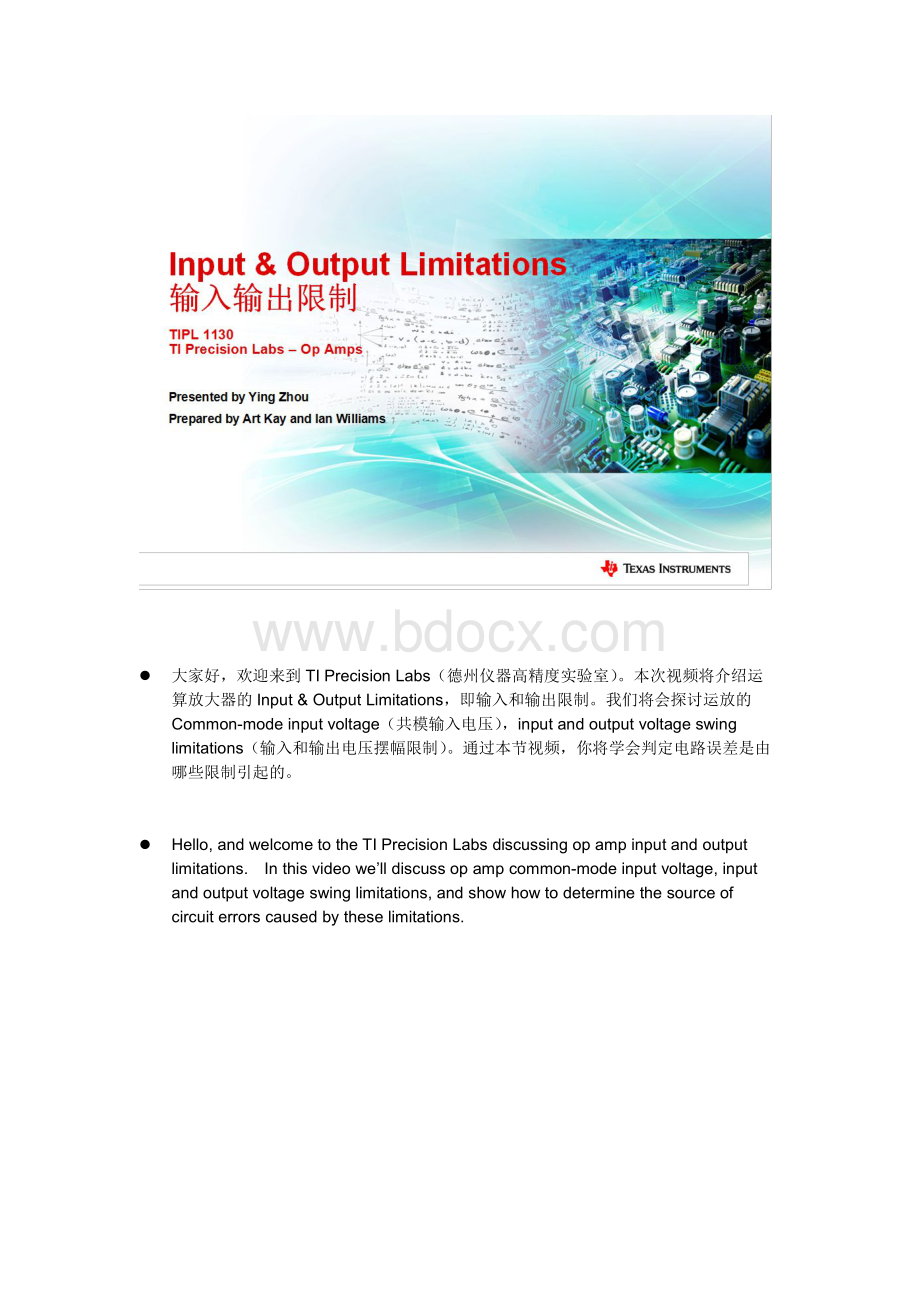运算放大器:输入和输出限制资料下载.pdf
《运算放大器:输入和输出限制资料下载.pdf》由会员分享,可在线阅读,更多相关《运算放大器:输入和输出限制资料下载.pdf(18页珍藏版)》请在冰豆网上搜索。

我们将会探讨运放的Common-modeinputvoltage(共模输入电压),inputandoutputvoltageswinglimitations(输入和输出电压摆幅限制)。
通过本节视频,你将学会判定电路误差是由哪些限制引起的。
Hello,andwelcometotheTIPrecisionLabsdiscussingopampinputandoutputlimitations.Inthisvideowelldiscussopampcommon-modeinputvoltage,inputandoutputvoltageswinglimitations,andshowhowtodeterminethesourceofcircuiterrorscausedbytheselimitations.首先,我们来看一个简单的non-invertingbuffercircuit(同相缓冲电路),也就是电压跟随器。
同相输入端输入的是一个三角波信号,幅度从-1.5V到+1.5V。
正常情况下,输出端将会得到一个一模一样的信号。
但实际上由于某些原因,这个运放的输出不可能超过1V。
这种非线性就叫做clipping(“削波”)。
是什么引起了这种“削波”现象呢?
稍后我们会回答这个问题,现在我们先要明确一些术语的定义。
Letsstartbyconsideringthissimplenon-invertingbuffercircuit.Antriangle-waveinputsignalof+/-1.5Visappliedtothenon-invertinginput,andonemightexpecttheoutputtolookexactlythesame.Forsomereason,theopampoutputdoesnotincreasepast+1V.Thistypeofnonlinearityiscalled“clipping.”Whatiscausingthisclippingbehavior?
Wellanswerthisquestionlaterinthepresentation,butfirstletsdefinesometermsthatarenecessarytoproperlyunderstandthisissue.Commonmodevoltage(共模电压)是指放大器两个输入端的平均电压。
对于运放来说,它的两个输入端电平几乎是一样的,两者只相差一个很小的offset(失调电压值),所以你在每一个输入端上都能看到这个共模信号。
Commonmodevoltageisdefinedastheaveragevoltagewhichisappliedtothetwoinputsofanamplifier.Inthecaseofanopamp,thetwoinputsareatthepracticallysamepotential,withonlyasmalloffsetbetweenthem.So,effectivelyyoucanseethecommonmodevoltageoneitherinput.共模输入电压范围也叫inputvoltageswing(输入电压摆幅)。
它定义了放大器正常线性工作所需的输入共模电压范围。
共模输入电压范围通常是相对于正电源和负电源而定义的。
如果超过这个共模输入范围,输出信号会变成非线性。
Outputvoltageswing(输出电压摆幅)则是指输出信号线性工作时的输出电压范围。
输出摆幅同样也是相对于供电电源而定义的。
如果超过运放的输出摆幅参数指标,输出信号将会失真或者出现非线性。
Commonmodeinputvoltagerangeisalsoknownasinputvoltageswing.Thistermdescribestherangeofinputcommonmodevoltagesthatcanbeusedfornormallinearoperationoftheamplifier.Thecommonmodeinputvoltagerangeisalwaysdefinedrelativetothepositivesupplyandthenegativesupply.Whenyouexceedthecommonmodeinputrange,theoutputbecomesnonlinear.Outputvoltageswingistherangeofoutputvoltagesthatallowforlinearoperationofoutputsignals.Outputswingisalsodefinedrelativetothepowersupplies.Theoutputsignalbecomesdistortedandnon-linearifyouexceedtheopampsoutputswingspecifications.现在我们看一看在数据手册中共模电压和输入输出电压摆幅是如何定义的。
共模电压范围的最小值和最大值是相对于供电电源定义的。
如图所示,负电源V-是0V,则共模输入电压的最小值为0V减去0.1V,即-0.1V。
正电源V+是5V,则5V减去3.5V,我们得到共模输入电压的最大值是1.5V。
因此,只要共模输入电压小于-0.1V或者大于1.5V,输出信号都会变成非线性。
输出摆幅如表中所示,同样地,它也是相对于供电电源定义的。
最小输出电压是V-+0.2V,因为这里负电源V-是0V,所以最小输出电压为0.2V,而最大输出电压是V+-0.2V,即4.8V。
任何低于0.2V或者高于4.8V的输出都会导致非线性。
Letslookathowcommonmodevoltageandinputandoutputvoltageswingaretypicallydefinedonadatasheet.Thecommonmodevoltagerangeisdefinedherewiththeminimumandmaximumlimitsgivenrelativetothepowersupplies.Thenegativesupply,V-,iszerovoltsinthiscase,sozerovoltsminus0.1Vgivesus-0.1Vfortheminimumcommonmodelimitation.Thepositivesupply,V+,is5V,so5Vminus3.5Vgivesus1.5Vforthemaximumcommonmodelimitation.Therefore,applyinganinputcommonmodevoltagebelow-0.1Vorabove1.5Vwillresultinnonlinearoutput.Theoutputswingisgivenhere,anditsthesametypeofdefinitionwhichisrelativetothesupplyvoltages.TheminimumoutputvoltageisV-+0.2V,or0.2Vinthiscase,andthemaximumoutputvoltageisV+-0.2V,or4.8V.Drivingtheoutputbelow0.2Vorabove4.8Vwillcausetheoutputtobecomenonlinear.现在我们来探讨一下是放大器的什么因素导致了输入输出限制。
左图显示的是一个典型的CMOS输入级,随着共模输入信号接近正电源或者负电源,输入晶体管会相应地saturate(饱和)或cutoff(截止),这些都是非线性工作的状态,意味着此时放大器不能线性放大输入信号。
这就是引起共模输入电压限制的原因。
大家需要记住的是,一些CMOS放大器的共模限制可能很接近甚至超过供电电源轨。
输出级的电压摆幅限制则是由于内部晶体管的饱和和压降引起的。
CMOS放大器的输出电压限制比较小,因为CMOS晶体管的饱和电压比较低。
我们通常所说的rail-to-railamplifiers(“轨对轨放大器”)指的是,共模输入电压范围可以达到供电电源的两个轨、并且输出电压接近供电电源轨的放大器。
Letsdiscusswhatelementsinsidetheamplifieractuallycausetheinputandoutputlimitations.OntheleftyoucanseeatypicalCMOSinputstage.Asthecommonmodeinputsignalapproacheseitherthepositiveornegativesupply,theinputtransistorswilleithersaturateorcutoff.Saturationandcutoffarebothnonlinearmodesofoperation,sotheamplifiercannotlinearlyamplifytheinputsignal.Thisiswhatcausesthecommonmodeinputvoltagelimitation.PleasekeepinmindthatsomeCMOSamplifiershavecommonmodelimitationswhichareverynearorevenbeyondthepowersupplyrails.Theoutputstagevoltageswinglimitationcausedbythesaturationanddiodedropsoninternaltransistors.CMOSamplifierstendtohavebetteroutputvoltageswinglimitations,becauseCMOStransistorscanhavelowersaturationvoltages.Amplifierswhichcanacceptcommonmodeinputvoltagerangesuptothepowersupplyrails,andcanswingtheoutputvoltagenearthesupplyrails,arereferredtoasrail-to-railamplifiers.下面给出两个电路的例子,两者有不同的共模输入考虑。
左图显示的是invertingconfiguration(反